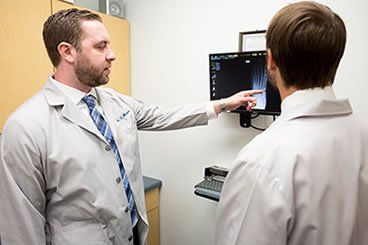Lake Zurich Foot Clinic Foot Injuries
Injuries to the foot can be quite common and painful. As with many injuries, it is important to first isolate the problem to determine the best mode of treatment. If you have a new injury to your foot or lingering pain from an old injury, contact an experienced podiatric specialist
to begin the healing process. Your podiatrist will discuss with you how the injury occurred and work with the affected area to determine the exact location of the injury and get an understanding of your range of motion. An x-ray may be used to determine if the bone has been fractured or broken.
Treatments for foot injuries are as varied as the injuries themselves. Once your podiatrist has determined if you are suffering from a strain or sprain, break or fracture you will receive the highest level of care to get you on your feet again. Whether you need a cast or brace or just a regimen of heat, ice or stretching, you will leave our offices knowing that you are on your way to feeling better. Contact us today to have an experienced professional examine your foot injury and prescribe a treatment method that will give you the best results possible.
Running Injuries
When one is an avid runner, there are a variety of injuries they can incur throughout their training. They range from mildly annoying to something requiring physical therapy or even surgery. To ensure that you take proper care of your body, make sure that you stretch properly, wear appropriate footwear and listen to your body telling you to rest.
A Few Common Running Injuries Include:
Pulled Hamstring:
A pulled hamstring is an injury to the hamstring muscle. It causes mild to severe pain in the area.
Hip Stress Fractures:
Stress fractures of the hip are most common in long-distance runners where there is constant repetitive motion in the hip.
Shin Splints:
Shin splint pain can be due to is generally associated with any pain in the bone between the knee and ankle.
Achilles Tendonitis:
Achilles tendonitis is a painful condition of the tendon in the back of the ankle. Left untreated, Achilles tendonitis can lead to an increased risk of Achilles tendon rupture.
Plantar Fasciitis:
Plantar fasciitis is a pain in the heel caused by inflammation of the thick ligament of the base of the foot. Plantar fasciitis can cause pain when walking or running, and lead to the formation of a heel spur.
Arch Pain:
Arch pain, also sometimes called a strain, often causes inflammation and a burning sensation under the arch of the foot.
Sprains/Strains
When you experience pain when working out, you may wonder what kind of injury you have actually incurred. Most often, you’ll have a sprain or a strain of your muscle. How do you know the difference and how do you treat them?
A sprain is a stretch and/or tear of a ligament. A ligament is the fibrous band of connective tissue that joins the ends two bones together. Ligaments stabilize and support the body's joints. For example, ligaments in the knee connect the upper leg with the lower leg, enabling people to walk and run.
A sprain
is caused by direct or indirect trauma that knocks a joint out of position, overstretches it or, in severe cases, ruptures the supporting ligaments. Typically, this injury occurs when an individual falls and lands on an outstretched arm, the side of the foot or runs on an uneven surface.
Symptoms Include:
- Pain
- Bruising
- Swelling
- Inflammation
The individual oftentimes feels a tear or pop in the joint. In severe cases, this may make the joint nonfunctional. In other cases, where the sprain partially tears the ligament, some swelling may occur.
A
strain
is an injury of a muscle or tendon. Tendons are fibrous cords of tissue that attach muscles to bone.
Chronic strains are the result of prolonged, repetitive movements of muscles and tendons. Insufficient breaks during intensive training oftentimes lead to a strain. Symptoms of a strain include pain, muscle spasm, muscle weakness, swelling, inflammation, and cramping. In severe strains, the muscle and/or tendon are partially or completely ruptured, often incapacitating the individual.
There is no way to make yourself immune to sprains and strains, but proper stretching, appropriate footwear and warming up before engaging in physical activity will help alleviate these potential problems.
Browse Our Website
Contact Information
Office Information
Located in the Willow Ponds Professional Center
950 West IL Route 22, Suite 105
Lake Zurich, Illinois 60047
Phone: (847) 540-0234
Fax: 847-540-0867
Email: info@lakezurichfootclinic.com
Office Hours- By Appointment Only!
Monday- 9:00 am- 5:00 pm
Tuesday- 9:00 am- 5:00 pm
Wednesday- 9:00 am- 5:00 pm
Thursday- 9:00 am- 6:00 pm
Friday- 9:00 am- 2:00 pm
Saturday- 8:00 am- 12:00 pm
Sunday- Closed
Send us a Message
Contact Us
Thank you for contacting us.
We will get back to you as soon as possible.
We will get back to you as soon as possible.
Oops, there was an error sending your message.
Please try again later.
Please try again later.
Content, including images, displayed on this website is protected by copyright laws. Downloading, republication, retransmission or reproduction of content on this website is strictly prohibited. Terms of Use
| Privacy Policy


